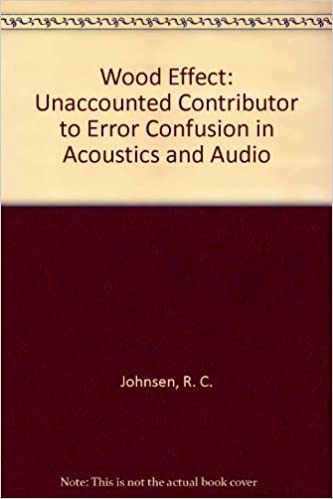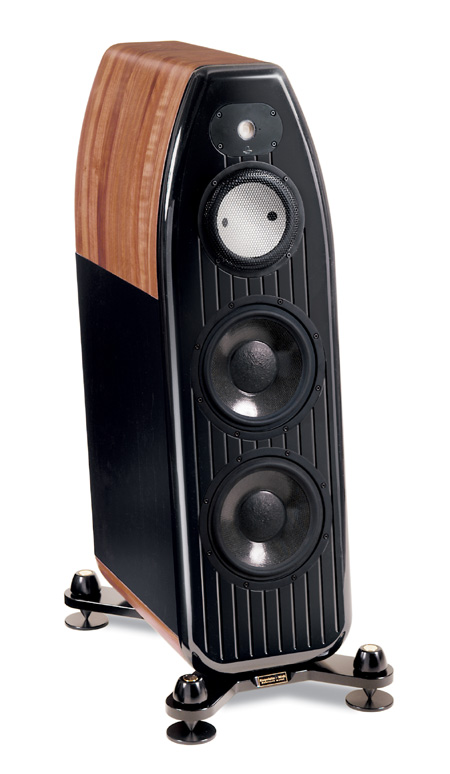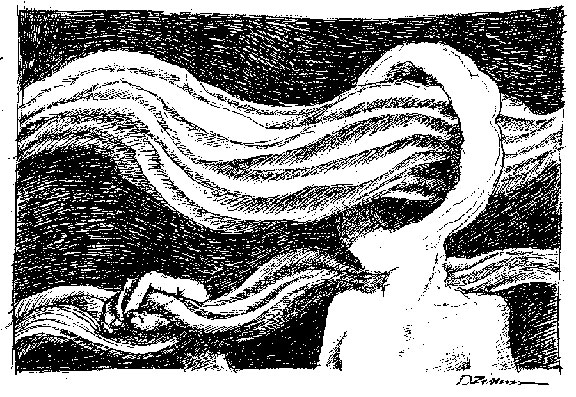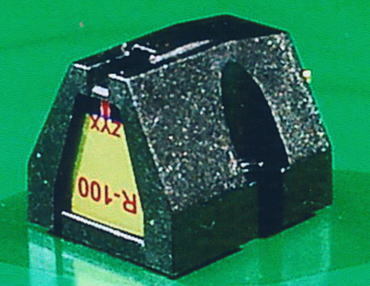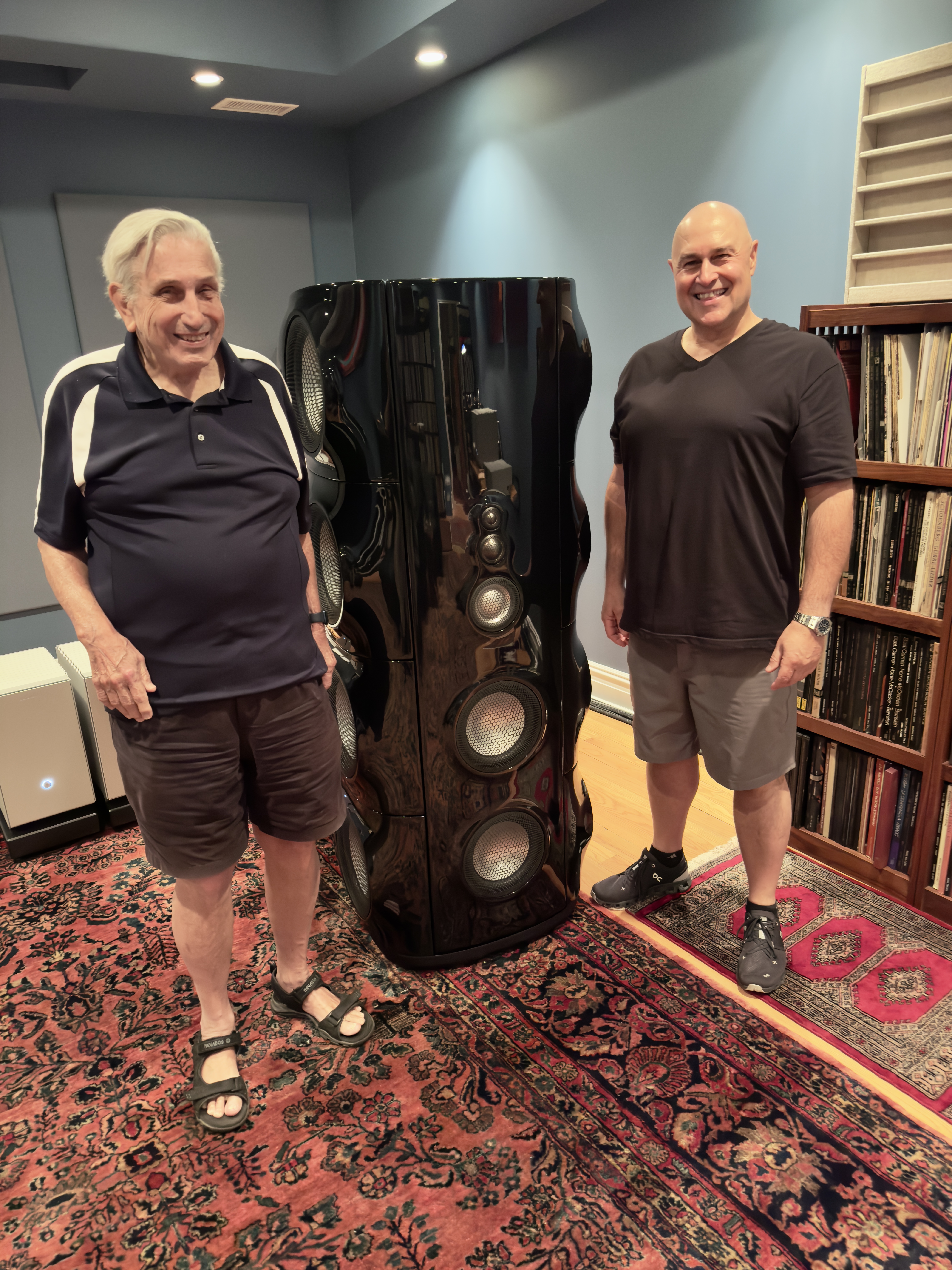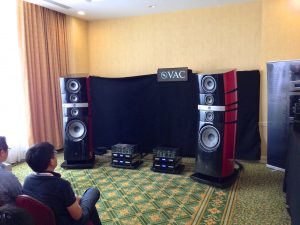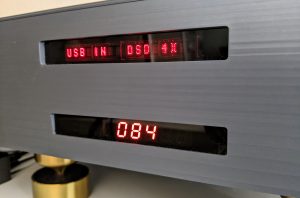Clark Johnsen
New Old Stock - Articles from Our Days in Print
The topic of acoustic polarity, also known as Absolute Polarity, has cropped up again recently. No surprise—since 1962 it's lingered in the professional literature, where most researchers claim that polarity matters greatly. But today, who cares?
For that sorry state of affairs, you can blame the commercial audio press. For whatever reason, hardly a whiff of this vital phenomenon ever appears in those precincts. Ultimate Audio, with two feature articles, became by default an exemplar of polarity awareness—quite so, as ultimate audio cannot be achieved without it! A personal disclaimer: I have often called polarity the sine qua non of correct audio practice. As author of the only book on the topic (The Wood Effect: Unaccounted Contributor to Error and Confusion in Acoustics and Audio, ISBN 0-929383-00-1), which explains everything, I naturally applaud the renewed attention. And I remember how Michael Gindi, an Ultimate Audio contributor, once toured the Stereophile Show chanting, "If you can't hear the Wood Effect, you can't hear!" I expect he still stands by that, though nary a peep recently.
Oh, the Wood Effect. Discovered by Charles Wood at the Defense Research Laboratory in 1957, it was first reported in 1962 in the Journal of the Acoustical Society of America. "Wood used as a signal a sinusoid partially clipped during half of each cycle. The resulting sound had a different timbre when the flat-topped portion was presented to the ear as a rarefaction, than it did when leads were reversed and the flat-topped portion was presented as a compression." There you have it, ladies and gentlemen: An asymmetric sinusoidal signal, presented those two dissimilar ways, with no other distortion, was proven to sound very different each way. Let's see, what else in the sonic realm generates asymmetric signals? Well, ta da! That would be musical instruments! Which explains how polarity permeates our entire audio world, albeit through negligence, because we hear normal and inverted polarity (more accurately, compression and rarefaction) so very dissimilarly, ,yet rarely are they differentiated by us in playback.
The abstract to The Wood Effect says it best: "Masked by random combination with other distortions in the music reproduction chain, an unsuspected major contributor has lain hidden: Aural sensitivity to 'phase inversion'—the Wood Effect."
"Music normally creates compression waves. Electronics, however, often invert that natural, positive polarity to unnatural, negative rarefaction, thus diminishing physical and aesthetic impact. The term Absolute Polarity uniquely describes the correct arrival to the ear of wavefronts from loudspeakers, with respect to actual musical instruments."
"Wrong polarity, when isolated, is obvious to everyone. Its present neglect results from habitual disregard for phase response, especially in loudspeakers."
Phase accuracy has never much mattered to speaker designers (I might have continued), producing what Richard Greiner has termed "the crossover catastrophe," referring to high-order crossovers that blunt the polarity sense. We must also endure a haphazard engraving of polarity on delivery media, which causes variances from disc to disc, from side to side, from cut to cut, and even within a single cut. Thoroughly permeated by all that confusion, many people throw up their hands in despair and declare that polarity cannot matter. But they are wrong, and therein hangs a tale. Polarity, in its pure state, as with one musical instrument recorded on one channel (designated. a monaural phase effect, or MPE), is perfectly audible, and provably so. Reproduced incorrectly, it becomes what I call "the muffling distortion," because our ears detect an inverted leading transient and suppress the impulse response. Thus the pluck on a guitar string, so striking in real life, becomes dull, muted, and inexpressive. A musician might say, "You can't hear the fingers, man."
So? So, to repeat, Absolute Polarity, which earns caps by defining the only true absolute in audio, requires that the loudspeaker (whichever way the recording may be) generate a compression wave whenever the actual musical instrument does. Live music has punch, but music often lacks that aspect when heard over an audio system; that's your polarity distortion.
But how to explain? How does impact so often become expact? How sound becomes... muffled? Without a protocol as to how any recorded medium should store positive polarity—a one or a zero, an inside or an outside groove excursion, don't ask the AES!—the randomness among tape recorders, studio toys and mastering gear is transferred onto delivery media in similar fashion and left for correction by... what? Only our ears! Pretty weird, huh? You actually have to listen to tell which way is right? No meters, no nothing to assist? God! What's wrong with those audio engineers? Where are they when you really need them?
To those of us who hear polarity, and we are legion, this whole state of affairs seems ludicrous. Over a low-phase-distortion audio system, no one ever misses the right call. Never! For example, everyone who crosses my own threshold gets it by the second try. Later, granted, people become dissatisfied with the situation and begin to berate the recording industry and the electronics manufacturers, who rarely provide compensation for polarity. Nor is the press exempted from obloquy, along with our vaunted high end "designers," who largely ignore polarity. Those listeners who know about it, however, mostly blame the press for not informing them earlier, and for being more interested in promoting new gear for sale, at the expense of basic principles.
Readers should be grateful therefore for any assistance at all; and this phenomenon of Absolute Polarity apprises them of a major improvement, available without purchase of anything new. Better sound for free, as I have proclaimed for years. How often do you find that? (Although one could do worse than to invest in the Remote Phono Polarity Control from Lewis Labs. The wired version sells for $400, the wireless for $650.)
But as to why I'm on the case again, there are problems in those Ultimate Audio articles by Mrs. Herron and Fredell—and elsewhere too, notably in an e-zine, in a piece authored by Doug Blackburn, outstanding for its wrong-headedness. These writers (and many others, too) confuse small-case polarity with Absolute Polarity. Also, they use "polarity" interchangeably with "phase." Phase could mean any degree, while polarity denotes precisely the 180° condition. Third, they all seem to think that the Absolute inheres in recorded media, whereas in truth it occurs only at the final impingement point: your ear. To quote Mr. Herron: "Absolute polarity can be lost... and again restored in many places in the recording and playback chain." No, Keith! You mean, simply, polarity. And not "lost," either: polarity never disappears, it only reverses itself, time and again.
Then Mr. Fredell: "Remember, a musical instrument has one polarity—the absolute polarity." No, Lars; an instrument has only its own polarity. It falls on us to recognize the Absolute at our ears, for right reproduction. Not to beat an almost-dead horse, but here's Sedrick Harris, too, in Ultimate Audio (Fall 2000): "Note: The absolute polarity of this recording is 180° wrong." No! The Absolute is achieved only case by case; it is not written into law regarding any groove or any gear. Never mind that Harry Pearson, Robert Harley, and scores of others who should know better have made the same mistake, readers by now should recognize their common error, which allows confusion to reign.
Confusion reigns perhaps nowhere more so than in Doug Blackburn's peculiar column on Soundstage (October 1999). Let the record show, I once entertained Doug and his droll wife Tracy at The Listening Studio, then back home for dinner, and we got along just fine. Afterwards, he hardly spoke to me again, and published an article about the Vibraplane that, to my mind, quite misrepresented it. Later he wrote a long-winded article opposing polarity without once acknowledging my book or its arguments. I do not take that personally, but since I am about to disrupt his party, the question might arise.
Mr. Blackburn begins his tale auspiciously enough: "When the scientist selects a test with hidden variables, the test may end up being invalidated later." Quite right, but then: "The experiments that prove polarity is audible have been incorrectly performed for decades." Very well, how? "In every case I've seen, these experiments are conducted by reversing the connections somewhere in the audio signal chain." All right, what's wrong with that? "None of those methods are adequate for evaluating the audibility of polarity reversal." And why not? "When you reverse the connections at a loudspeaker... you also reverse the direction the audio signal is applied to wire in the loudspeaker."
There you have it, ladies and gentlemen. No one who performed these experiments "ever seems to have evaluated the audibility of reversal of direction of signal travel in wires... All of them made the same mistake—assuming that polarity reversal is the cause of the change in sound they hear." So the trick's in the metal! "This information would seem to imply that switching polarity could very well be inaudible." How to respond to what I would call errant nonsense? Well, for one thing, I am conversant with wire-direction anomalies. I keep one set of cables hanging around, not because they sound good (they don't), but to demonstrate the aural effect of reversal, which in this case is fairly dramatic—but nothing like polarity. Doug is correct about wire directionality; where he errs is in attributing the whole of polarity audibility to that phenomenon.
Other objections to his thesis quickly arise. For instance, what if the reversal is accomplished with an internal switch? Very little wire within a switch! Ah, but Blackburn argues that "reversing the direction the audio signal is applied" to any wire produces his effect, which means that even switching cartridge leads, or bits in the digital domain, will change the performance of all wires following. Likewise, switching even the internal loudspeaker leads right at the drivers—after all, there are still the coil windings in which the signal may be altered by those nonlinearities we (wrongly) associate with polarity. Don't forget, "reversing the direction the audio signal is applied to wire in the loudspeaker" explains the entire phenomenon. Whatever expanse of wire may be involved following the switch point, we are assured that only it must be blamed for what we hear.
Let's inspect that claim more closely. Just what does the writer mean? It's not "hot" and "cold" that are actually switched. Ground remains grounded, nor do electrons change their general direction of travel with audio polarity reversal. Wires know nothing about acoustic compression and rarefaction wavefronts. In any event, they represent the opposite sides of a sine wave slope, both of which they pass with equal ease. With signals continuously fluctuating, as musical instruments comprise a mix of both modes, are we to suppose that wires somehow differentiate these? That would be the result required by Blackburn's astonishing, but ultimately insupportable analysis.
I cannot imagine why he feels the need to deny a perfectly obvious and simple physical principle, thus doing Soundstage readers a severe disservice. Perhaps his confusion arises from that common misapprehension: "You really need to use recordings that are known to be polarity correct." Once again: There are no standards for "polarity correctness" on tapes, records, or CDs. None. Nada. It is a fantasy that leads you astray.
Another fantasy?
The estimable Keith Herron, in his article "Is Absolute Polarity Absolute?" (Ultimate Audio, Fall 2000), begins very logically, too. "Is absolute polarity audible? Absolutely!" But then immediately we are told, "But what are you really hearing when you flip that polarity switch—or reverse those speaker wires?" Uh oh! Could it be... something else again? Yes, as it happens. "Did adding the phase inverter change the sound? You bet! But it also changed the measurable distortion products." And beyond that, "Will the speaker cone go in, exactly the same way it goes out?" Those arguments have been heard before, and the only proper reply is, so what? We learn to live with electronic distortion, and in fact some speakers—ribbons, for instance—don't even have cones, yet reproduce polarity effects clearly. Mr. Herron concludes his sadly obfuscatory article on this somewhat weasely note: "It just might be that distortion products in the recording process cancel or add differently with those in the playback process. Is there anything absolute about this? Absolutely not!"
The final pitch.
Just a couple things to wind up. The fact that ever-popular high-order speaker crossovers perilously blunt the polarity sense was ignored in these recent articles. And, while Lars' laudable call for panel (or remote control) polarity switches should be heeded, many such, for whatever reason, barely reveal the polarity condition, even in the vaunted digital domain. The best way to teach yourself—pace, Doug Blackburn—is to reverse all four (or eight) speaker wires, tediously back and forth, to learn the condition, then play it from there. Your rewards will more than compensate the effort, believe me! Remember, no one ever promised you that audio would be easy.
Finally, I must dispute Lars' list of polarities by CD label, which he first published several years ago in Fi. While perhaps useful as a rough guide, such happy consistency rarely obtains, except perhaps for some very small labels. Major labels split pretty much 50/50, as the laws of statistics demand whenever no control is exerted over a binary event. To whatever extent Lars may be right, his evaluation applies only to the opening bands; subsequent ones can vary willy-nilly.
That very confusing 50/50 split was the central revelation of The Wood Effect, remaining as true today as ever, sad to say. For a superlative corroboration of that principle, I offer Lars' list itself: Its 88 entries for label polarity are tellingly divided 43/45. Eternal vigilance is ever the price of the true Absolute.
JUST ONE WORD: AURIOS
Aurios, pronounced as in the famous Nabisco cookie, are isolation devices from Vistek, not otherwise an audio company. Regardless of all the favorable Net chitchat, Aurios are very, very good, at $300 the set of three. A captured-ball-bearing, hard-metal design, Aurios claim lateral isolation down to 1Hz, which, if true, puts them into expensive Vibraplane territory; and as most of my readers already know, horizontal vibrations are more injurious, and harder to eliminate, than the vertical.
Two performance examples. In my s**tbox system at home, where tweaky-type improvements (except CD carving and degaussing) are hardly noticeable, thank God, the happy effect of Aurios under my Jolida CD player is inescapable. And in my two-bit home theater room (okay, four-bit), placing them under a lowly Panasonic DVD player results not just in cleaner sound, but in an increased ability to (get this!) perceive a wide stereo image from each end of the sofa. That one I'll have to think about. The Aurios guys also make very unlikely claims for their product's utility under speakers. I haven't heard them that way yet, but I know many people who swear by them there.
On the downside, Aurios require an extremely level surface, they provide no vertical isolation, and stiff cables are a no-no. However, trimming shims are supplied, and the vertical element can be controlled with a proper shelf and/or supplementary feet. Or you can upgrade to the Professional Aurios ($600/set), which allow any cable stiffness you like, incorporate vertical isolation, and don't require leveling, so you win all around.
While Aurios are not exactly cheap, I know of nothing at less than thrice the price that gets you there. Until you've experienced effective horizontal isolation from the vibration environment, you may not know what resolution and detail are.
FORMAT WARS: THE END OF RECORDED HISTORY?
In our last issue I began a lengthy rumination on Napster and such. It got left "To be continued" because I was unable to digest the vast amount of recent information and merge it into my thinking before deadline. In the meantime, much of what I wanted to say has appeared elsewhere, so I'll cut right to the scene before the chase. 'Way back in '98 (Positive Feedback,Vol.7, No. 4) I boldly asserted that, as a long-term item, DVD is dead. That was because DVD cannot (even nearly) contain HDTV: "DVD has become a foundling, a mere interim format. Unload it on the home-theater suckers, to replace their laserdiscs and tapes, then switch 'em to something fully widescreen, high-def and digital, that's the plan." Prescient words, those, if I may say, and they echo my epochal 1988 entry in Fanfare: "And there is the tragedy of digital audio. Its framers were unaware of how well early LPs sound on modern players, so they chose their numbers carelessly, and moreover hitched masters, players and discs alike onto the foot of a rapidly rising technology curve. Just wait; everyone will discover the error of their ways and make amends. And soon we shall have CD Mk.II (already in the prototype lab) and CD Mk.III (already on the drawing board), then phoneline CTS (CompuTeleSonics)."
Hey, was that good? I predicted DVD-A and SACD and MP3, failing only to imagine wireless net and Napster. But it's not about sound at all, none of it. As I explained in Part I, we do not yet know the contents of our CDs, nor of our LPs; we do not even really know old 78s! But here we go, salivating over one new format after another, as directed by the recording industry and its lapdog press. Oh, how they rub their hands in glee over their accomplishment, knowing full well that the justification for new formats is not better sound (or image) per se, but that we should all be made to buy replacement collections.
Induced anxiety and contrived rivalry are nothing new on the scene: Records would kill sheet music, radio would kill records, video would kill the radio stars, 33s would kill 45s, home taping would kill music, VCRs would shutter movie theaters. Funny thing, all those businesses are now divisions of each other. Contemplation of that fact one night led me to this glittering apercu.: Format Wars Are Phony Wars. Yes! Look at that word, "phony." In Britain and the United States both, it means not:, as in not really, just sounds like. Phony. The Phony War, they called it, Over There in the European trenches. World War II (at least until 1941...).
Oh, the groundwork has been laid ever so skillfully once again. As stated, the popular DVD format does not contain sufficient bandwidth for HDTV, the (government-mandated) video medium of the future. Therefore we will need a new-type disc, or something, to handle High-Def. But over the decades, the music and movie people have become wedded to a business model that demands selling artifacts, not art. Now that must change somehow. Napster caught the recording industry napping. As it happens, that phrase is a terrific misnomer; they themselves do practically no recording nowadays, instead they manufacture and distribute and market. Twenty years ago, CDs seemed an amazing windfall, cheaper to make than LPs yet commanding twice the price. Today, digital encoding is giving them headaches. Pity. If the recording industry had just stuck with vinyl, they never would have had the Napster problem!
Today we approach The End of Recorded History, at least as we have known it, because what if, what if—and this will not be pleasant news—Napster and its adversaries should reach one of those "accords" on how music shall be delivered over the Net, to each party's keen satisfaction. And then it takes off! The industry finds itself making more money than ever! Hah! Soon, with net technology commanding the major market share, companies might start rethinking the bothersome business of manufacturing and distributing the shiny discs which most people, let's face it, play intensely for a time, then nevermore. Wouldn't it make much more sense, given the perishability associated with pop music's sell-by dates, to accomplish these exchanges entirely, exclusively electronically? No vexing shrink-wrapped packages, ever again?
To make matters even worse (for us), certain interested parties are developing codexes that eliminate even the one-time copy provision permitted (but not required) by law. (To get the details, go to www.toad.com/gnu/whatswrong.html). This truly scary scenario is due to be played out by 2008, by which time we shall all have become accustomed to wireless delivery, because quite plainly, despite all the legal ballyhoo, the attraction of Napster is not that the product is free, but rather, available on demand. No parking, no checkout lines, just sit at home—a delivery method perfectly tooled to this generation's version of instant gratification. Complete realization of that scheme would mean that most CD plants (given their reliance on pop program) would close and the last vestiges of alternative product disappear, including such minor-league stuff as classical music, jazz, and bluegrass, along with grand recording systems like DSD, for which quality the new downloading technology will have no use. With 95% of buyers tickled pink by MP3, who needs anything better? And who needs retailers either, those parasites! The Towers shall come tumbling down! One physical format however will survive, to bring discriminating listeners uncompressed, high-quality sound. Yes, vinyl shall outlive CD! Call me a futurist, or an ironist, if you will, but still, always watch out what you wish for. It might happen!
Oh, just one more thing
While I have predicted here the effective demise of the CD and the DVD, what if, a few years hence, there were a disc capable of holding, say, 400 times the information currently possible? Wouldn't that alter the situation? Oh, but surely that couldn't happen! Perhaps a visit to Constellation 3D of Concord, Massachusetts, is in order. (Hey! That's not far from me!) There, according to New Scientist, they are developing the FMVD (Fluorescent Multilayer Video Disc), able to hold (get this!) 1000 gigabytes—in industry parlance, one terabyte. Call it the Titanic in High-Def, with the best sound quality Mark Levinson could imagine, times twenty. That might change things. Napster himself, caught napping!
A GRAMOPHONE EVENING IN THE RITZ
Today I'm at the Peabody Museum in Salem, Massachusetts. "Witch City" it's called, although Salem was in fact the first shipbuilding capital of America, bolstering the great China trade that made New England prosperous. In a state that boasts the Boston Museum of Fine Arts and the MassMOCA and the Gardner and the Clark, the Peabody is a maritime museum par excellence.
Recently the Peabody modernized its exhibition practice with what it calls The Art Odyssey. The unaware visitor seeking a seagoing experience passes through silently-unfolding double doors, to be greeted by a huge rear-projection video screen displaying color filigrees, the hidden sound system playing, in close rotation, excerpts from the music of Mozart, Africa, Kiss, and more. The Art Odyssey encompasses areas of all three floors; on the third, a babble of voices is heard upon entering, as if from invisible space, people chattering about art and life and what-not, with different chat groups as one walks along. Overhead, one espies multiple clear-acrylic 16-inch-wide hanging domes with odd contrivances inside. These prove to be our spectral sound sources, each unit focused on the space directly beneath. The taped conversations are relentlessly trivial, however, and largely female too, alas—a twitter of high-pitched voices adding nothing significant to appreciation of art on the wall. It's an "installation," as they say, but worse than docents in explicating or enlarging upon what we view, and considerably more irritating. Maybe it's all a joke? Hey, the art's not so hot, either.
Before long I take refuge in what I have come here for, an exhibit of dazzling new prints struck from the original glass negatives of the Endurance expedition. What a story! Perhaps you haven't heard it. In the mostly British campaign to discover the South Pole, Robert Scott won, leaving Sir Ernest Shackelton, explorer extraordinaire, only one route to triumph in the historic antipodean race: the first crossing of the Antarctic continent, which he set out to do in 1914 aboard the yacht Endurance, christened from his family motto, which prophetically consisted of that single word. Reaching South Georgia Island, a Norwegian whaling outpost, he sailed on with thirty-five intrepid men (including one stowaway) through thick ice floes into the Waddell Sea until being blocked, at which point they were all stranded! The ship became their landlocked home for nine months, while the men amused themselves and kept their sled dogs in shape. Then came the dramatic ice heaves that listed the Endurance thirty degrees to port, then crushed her like a toy.
After that calamity, the men camped out with three upturned lifeboats, wood salvaged from the ship, and a fortunate two tons of provisions, eking out a meager existence for several months more, during what proved to be the worst winter in the Norwegians' memory, with precious little summer either. Recognizing that they must move on, Shackelton had the men build sleds for the lifeboats. With all the dogs already slaughtered for meat, they hauled the load themselves for a couple hundred miles to what seemed to be the coast and pitched tents again. Soon, however, Mr. Wild reported feeling seasick, and it was discovered that they were camped on a thin layer of ice floating over two thousand fathoms of roiling black water.
To reach actual land, Shackelton led the party onwards to Elephant Island. There the men regrouped, living off penguins and the occasional fat seal. Apprehending that their only hope of rescue was to send a small party in the sturdiest sailing dingy back to South Georgia Island, Shackelton chose his minimal crew shrewdly and shoved off. Five hundred miles of open sea under a mostly overcast sky were covered with only a sextant for guidance, at no-one-knows-what cost to the human spirit. Yet the little party managed to reach the island, though heavy storms forced a landing on the south coast opposite the outpost. Shackelton, accompanied by just one man, two axes, and ninety feet of rope (think: Survivor), set out across the interior mountains to reach civilization. Three times they ascended thousands of feet, only to find sheer drops on the other side. Finally they straggled, desperately, raggedly, into the whaling village. "Who the hell are you?!"" was the greeting they no doubt were accorded. One can well imagine the Norwegians' astonishment. "Shackelton here," he replied, the record shows.
After quickly retrieving the three left on the south shore, successive attempts were made, in different ships, to reach Elephant Island, the fourth finally succeeding. By this time, Shackelton had given up hope of finding his compatriots alive, but as it happened, the men were at lunch when the vessel was first espied by one who had stepped outside. "I say," he called back to the group, "have we any means of making smoke? I see a ship..."
Amidst general blubbering, and who can blame them, the expedition was reunited. Not one man had been lost in the two-year ordeal! They sailed back to Chile, thence triumphantly to England and to the Great War which was just commencing, in which several of the party's lives were later sacrificed. But all was not lost: Their prodigious achievement had been documented the entire way by staff photographer Frank Hurley. In addition to dozens of exposed glass plates (which he judiciously soldered into a tin box after the going got rough), Hurley had three rolls of film to use in a Brownie, which were shot very sparingly. He had also brought along the very latest in photographic technology: color plates. The Peabody exhibit I am at today therefore includes a set of backlit color transparencies of fairly astonishing vividness. Not only that, Hurley shot motion pictures. Yes! The Endurance expedition can be seen in full cinematography, including the brutal moment when the ice finally crushes their ship, and her masts and rigging topple. There you see it, captured for posterity, the same sight those seamen saw of their unhappy prospects back in 1914. Lucky for us, they had that solder.
But of all Hurley's excellent portraits of individuals and of their work and pastimes, and of the stark Antarctic scenery, the picture I shall remember best is the one entitled, "A Gramophone Evening in the Ritz." The Ritz was their name for the social cabin in the landlocked Endurance. In this shot we see people seated around a windup gramophone and a pile of perhaps sixty discs (how many more in the cabinet below?), everyone listening intently. Although the photograph was probably posed, one must wonder, what was that music?
Whatever, we do know that the men saved the gramophone and the records, trekking them along during their overland escape; beyond that, no information is given. One must suppose that the rig was played until the very end, as it had become the intrepid expeditioners' only physical connection to home and hearth. What music they heard would be interesting to learn, but that the men savored those recorded concerts, besides playing much whist and chess, cannot be contested. Primitive as the technology was, can any of us living in comfortable homes today claim to enjoy our time with exotic, high-fidelity, high end audio systems any the more?
Clark Johnsen passed away a year ago. His obituary can be found HERE.




